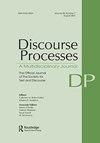将手势对单词学习的影响扩展到阅读:一项自定节奏阅读研究
IF 2.1
2区 心理学
Q2 PSYCHOLOGY, EDUCATIONAL
引用次数: 1
摘要
摘要综合起来,多媒体学习理论的连贯性原则和综合系统假说提出,共现的、语义一致的语言和视觉信息应该整合成一种增强记忆的心理表征。本文的目的是研究使用匹配手势和不匹配手势学习假词如何影响这些新学习的假词随后的识别和整合到阅读句子上下文中。此外,根据伪词的习得定义,伪词被操纵出现在语义一致或语义不一致的阅读句子上下文中。为了研究这个问题,我们采用了两个实验,利用自定节奏的阅读范式。实验1的结果表明部分支持综合系统假说。在实验2中,结果表明,根据综合系统假说和多媒体学习理论的连贯性原则,在语义一致的句子中,与语义不一致的句子相比,用匹配手势学习的假词在被阅读后能够更快、更准确地识别。报告了其他结果和所涉问题。本文章由计算机程序翻译,如有差异,请以英文原文为准。
Extending Gesture’s Impact on Word Learning to Reading: A Self-Paced Reading Study
ABSTRACT Taken together, the Coherence Principle of Multimedia Learning Theory and the Integrated Systems Hypothesis propose that co-occurring and semantically congruent verbal and visual information should be integrated into one mental representation that enhances memory. The purpose of this paper was to examine how learning pseudowords with matching versus mismatching gestures affects subsequent identification and integration of these newly learned pseudowords into read sentential contexts. Additionally, the pseudowords were manipulated to occur in either semantically congruent or semantically incongruent read sentential contexts, based on the pseudowords’ learned definition. To investigate the research question, two experiments utilizing self-paced reading paradigms were employed. Results of Experiment 1 indicated partial support for the Integrated Systems Hypothesis. In Experiment 2, results indicated that pseudowords learned with matching gestures were identified more quickly and accurately after being read in semantically congruent sentences compared to semantically incongruent sentences, as was expected based on the Integrated Systems Hypothesis as well as the Coherence Principle of Multimedia Learning Theory. Additional results and implications are reported.
求助全文
通过发布文献求助,成功后即可免费获取论文全文。
去求助
来源期刊

Discourse Processes
Multiple-
CiteScore
4.30
自引率
4.50%
发文量
27
期刊介绍:
Discourse Processes is a multidisciplinary journal providing a forum for cross-fertilization of ideas from diverse disciplines sharing a common interest in discourse--prose comprehension and recall, dialogue analysis, text grammar construction, computer simulation of natural language, cross-cultural comparisons of communicative competence, or related topics. The problems posed by multisentence contexts and the methods required to investigate them, although not always unique to discourse, are sufficiently distinct so as to require an organized mode of scientific interaction made possible through the journal.
 求助内容:
求助内容: 应助结果提醒方式:
应助结果提醒方式:


